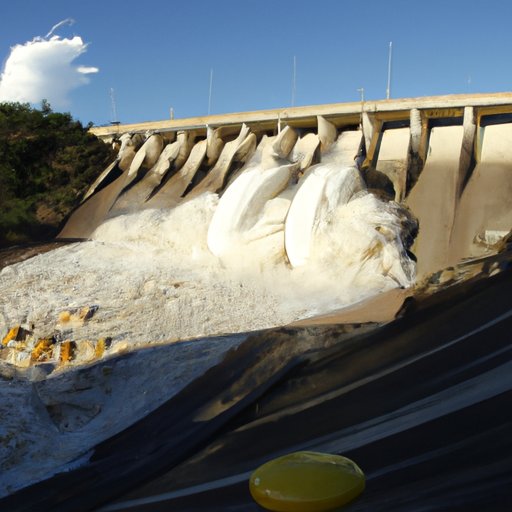Introduction
Hydroelectric power is a type of renewable energy source that uses the force of falling or flowing water to generate electricity. It is one of the oldest forms of energy production, and it has been used for centuries to power homes, factories, and other facilities. Hydroelectric power is an increasingly popular form of energy production because it is clean, efficient, and cost-effective. In this article, we will explore the basics of hydroelectric power, how it works, and its advantages, disadvantages, and potential for the future.

Explaining the Basics of Hydroelectric Power
Hydroelectric power is generated by using water to turn a turbine that is connected to a generator. The generator then converts the mechanical energy from the turbine into electrical energy. The process of generating electricity from water can be broken down into three main steps: collecting and storing water, releasing and controlling the flow of water, and generating electricity.
How Water is Used to Generate Electricity
When water flows through a turbine, it causes the turbine blades to spin. This spinning motion is then converted into mechanical energy, which is then transferred to the generator via a shaft. The generator then converts the mechanical energy into electrical energy, which is then sent out onto the power grid. According to the US Department of Energy, “Hydroelectricity is the most widely used form of renewable energy.”
Advantages of Using Hydroelectricity
Hydroelectric power has several advantages over other forms of energy production. It is a clean and renewable source of energy, meaning that it does not produce any air pollutants or greenhouse gases. Additionally, it is highly efficient, as it can convert up to 90% of the energy in the water into electricity. Finally, it is relatively inexpensive compared to other forms of energy production, making it a cost-effective option for many communities.

Describing the Components Used in a Hydroelectric System
The components of a hydroelectric system include turbines, generators, and dams. Turbines are the primary component of a hydroelectric system and are responsible for converting the energy in the water into mechanical energy. Generators are then used to convert the mechanical energy into electrical energy, which is then sent out onto the power grid. Dams are used to collect and store water, and they also help to regulate the flow of water.

Outlining the Process of Generating Electricity from Water
The process of generating electricity from water begins with collecting and storing water. Water is typically collected in a reservoir, which is then released when needed. Once the water is released, it passes through the turbine, causing it to spin and generate mechanical energy. This mechanical energy is then transferred to the generator, where it is converted into electrical energy. Finally, the electricity is sent out onto the power grid to be used by consumers.
Examining the Advantages and Disadvantages of Hydroelectric Power
Hydroelectric power has several environmental benefits. It does not produce any air pollutants or greenhouse gases, and it can help to reduce water consumption. Additionally, it is a renewable source of energy, meaning that it is not dependent on finite resources such as coal or oil. In terms of cost-effectiveness, hydroelectric power is relatively inexpensive compared to other forms of energy production. However, there are some potential drawbacks to using hydroelectric power. It requires a significant amount of infrastructure, and it can have a negative impact on the environment if it is not managed properly.
Investigating the History of Hydroelectric Power
The history of hydroelectric power stretches back to ancient times. People have used the power of water to generate energy since at least the first century AD. Early hydroelectric systems were used to power mills and other small-scale operations. Over time, these systems grew in size and complexity, and eventually, large-scale hydroelectric plants were built to generate electricity for entire cities. Today, hydroelectric power is still a major source of electricity in many countries around the world.
Evaluating Different Types of Hydroelectric Dams
There are several different types of hydroelectric dams, each with its own advantages and disadvantages. Gravity dams are the most common type of dam, and they are used to control water flow and generate electricity. Arch dams are curved structures that are designed to withstand strong currents, while embankment dams are made from earth and rock and are used to control large bodies of water. Each type of dam has its own unique characteristics, and they are all important components of a hydroelectric system.

Assessing the Future of Hydroelectric Power
As the demand for energy continues to increase, so too does the demand for renewable energy sources like hydroelectric power. Advances in technology are making hydroelectric systems more efficient and cost-effective, and new methods of harnessing the power of water are being developed. Additionally, governments are beginning to recognize the importance of renewable energy sources and are investing in research and development to make hydroelectric power more accessible. With these advances in technology, hydroelectric power has the potential to become an even more important part of the global energy mix in the future.
Conclusion
Hydroelectric power is a renewable energy source that has been used for centuries to generate electricity. It is a clean and efficient form of energy production, and it has several environmental and economic benefits. Hydroelectric systems use turbines, generators, and dams to convert the energy in moving water into electricity, and the process of generating electricity from water is relatively simple. Additionally, hydroelectric power has a long history and is becoming an increasingly important source of electricity in many countries. As the demand for energy continues to grow, hydroelectric power has the potential to become an even more important part of the global energy mix in the future.
(Note: Is this article not meeting your expectations? Do you have knowledge or insights to share? Unlock new opportunities and expand your reach by joining our authors team. Click Registration to join us and share your expertise with our readers.)
